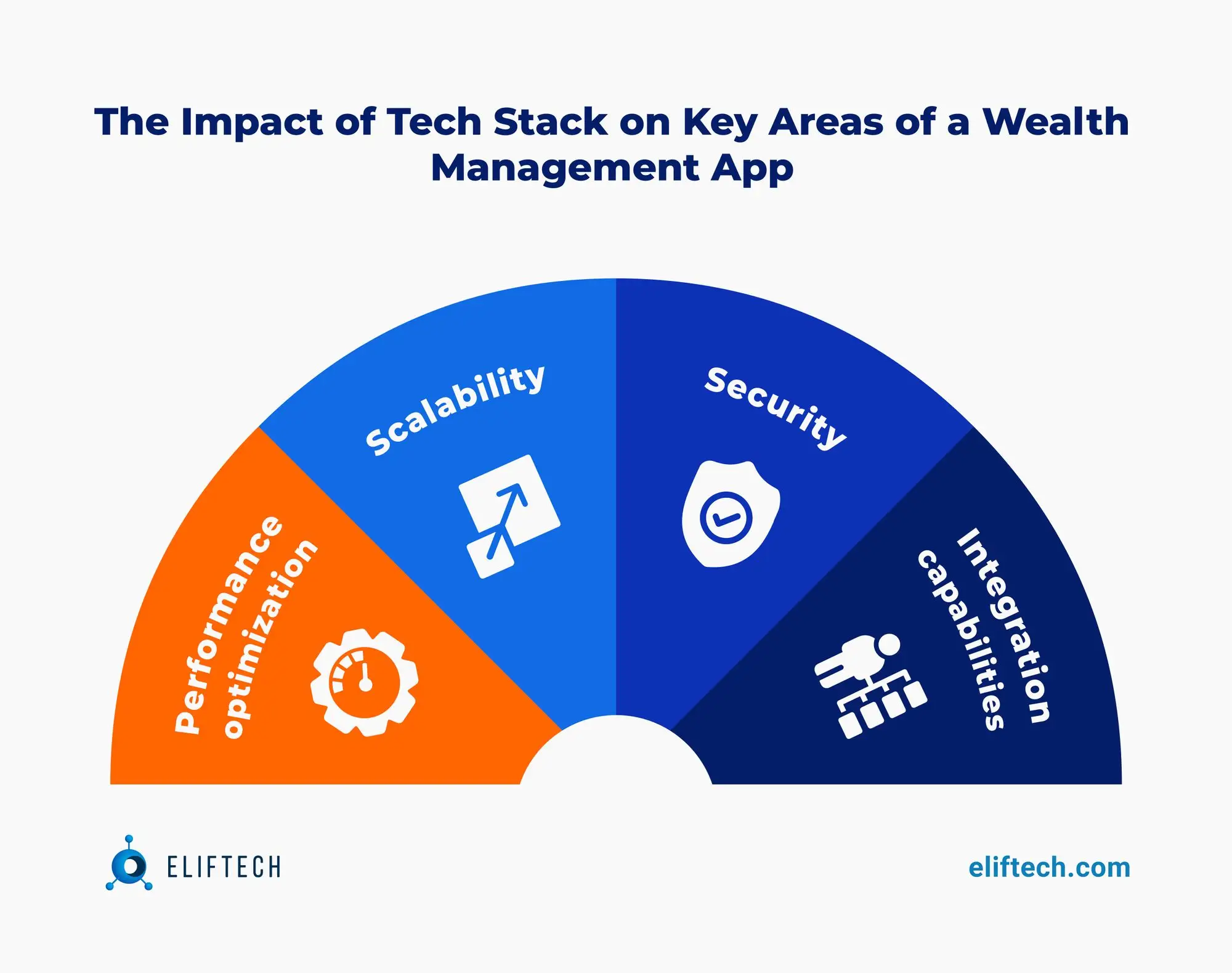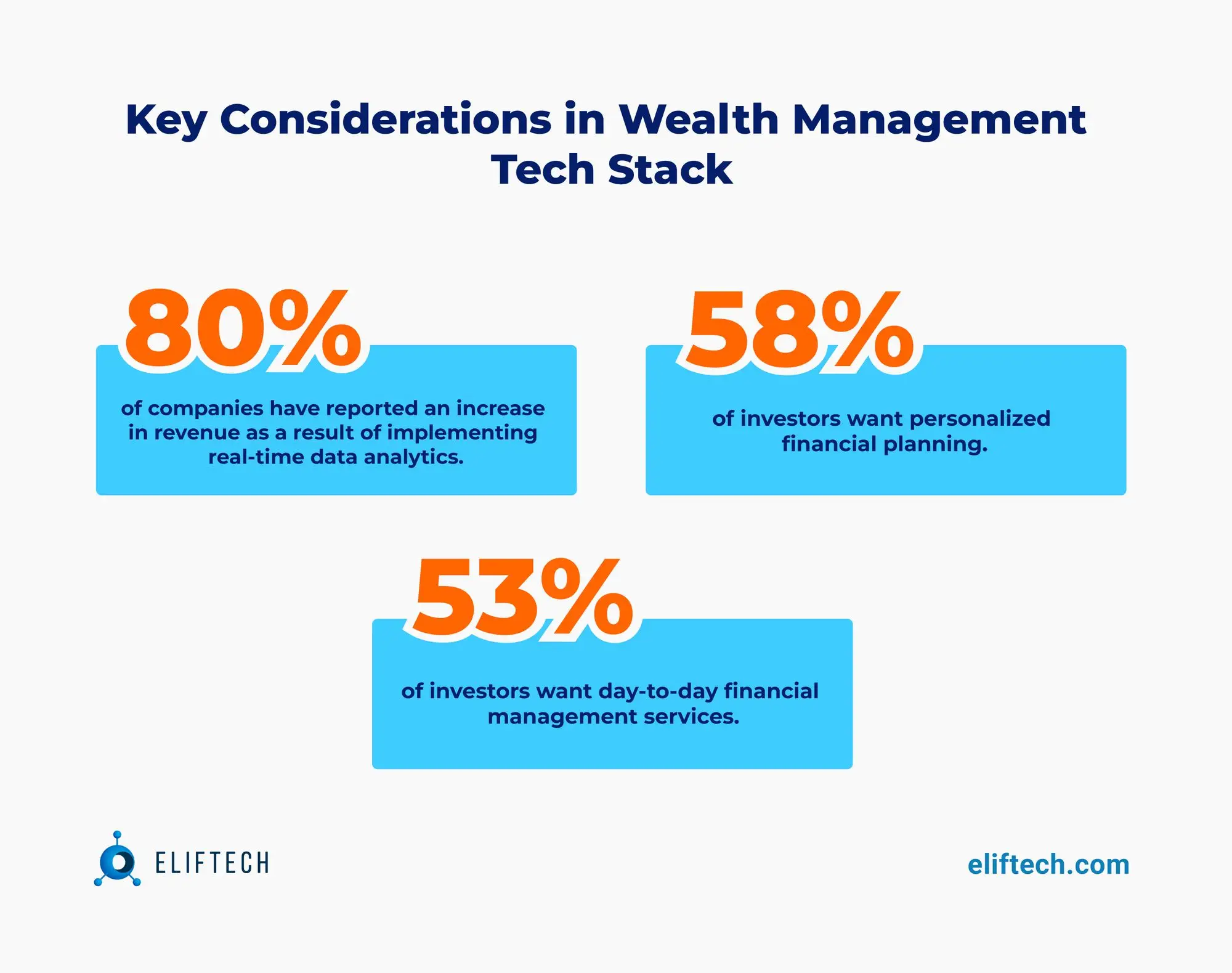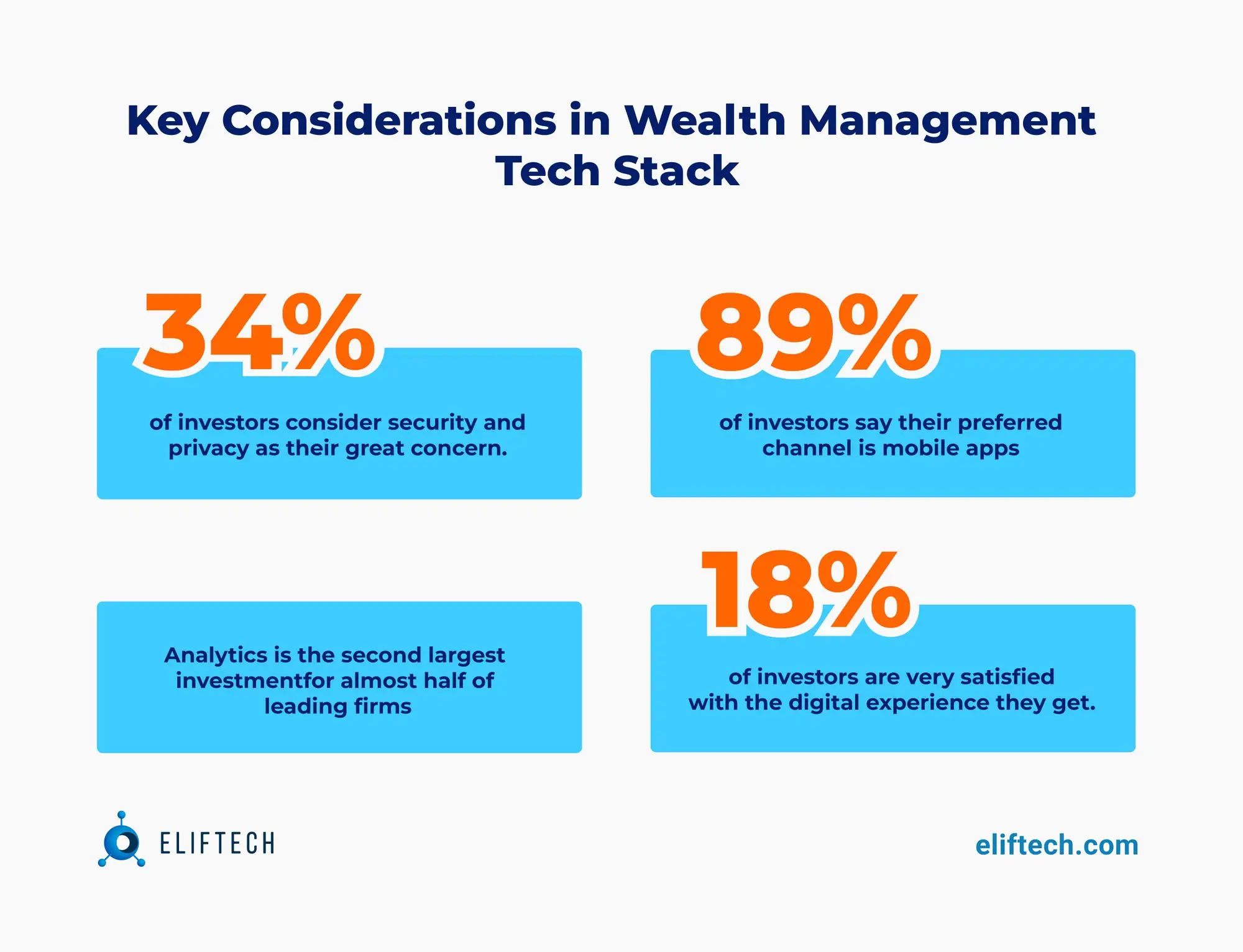Wealth Management
Wealth Management Tech Stack: Best Practices for Designing and Developing Wealth Management Apps

Digital wonders like wealth management apps provide users with a gateway to comprehensive financial management, enabling them to navigate investments, track portfolios, and make informed decisions with ease. Financial institutions and wealth management service providers recognize the importance of building a modern wealth management app that meets the needs of today’s investors.
A carefully curated technology stack serves as the backbone, seamlessly integrating powerful backend infrastructure, intelligent data analysis, captivating user interfaces, and robust security measures.
Join us in this post as we explore the essential components of the technology stack for wealth management app development. We will provide insights on how each component contributes to the app's overall performance and success.
Wealth Management Tech Stack: Essential Technologies for Building Your Wealth Management App
Building a successful wealth management app requires more than just a good idea. It requires a robust technology stack that can support the app's various functions and features.
An app's technology stack refers to the collection of programming languages, frameworks, and tools used to develop it. It impacts various aspects of the app, including performance optimization, scalability, security, and integration capabilities.

Let's take a closer look at how exactly the right wealth stack can impact each of these areas:
Performance optimization: Investors need real-time data and insights to make informed financial decisions. Thus, performance optimization is a crucial factor in a wealth management app. The technology stack used to develop an app significantly impacts its performance. For example, one of the most important factors affecting app speed and responsiveness is the programming language choice.
Scalability: As more users start to use the app, it becomes essential for it to handle a greater amount of traffic and data volume. The technology stack can impact app scalability. For example, using a cloud-based infrastructure can help ensure that the app can handle increased traffic and data volume.
Security: It is crucial for investors to have confidence that their financial information is secure and protected from any potential threats. Using encryption and secure authentication protocols can help protect user data from potential threats.
Integration capabilities: The app must be able to integrate with various financial institutions and services. The technology stack can impact app integration capabilities. For example, using APIs and microservices can help ensure that the app can integrate with various financial institutions and services.
Key Considerations in Wealth Management Tech Stack
When choosing wealth management tech stack, several factors should be considered:
App Requirements and Features
When choosing a technology stack for a wealth management app, it's essential to consider the app's requirements and features. The wealth stack should align with the app's goals and objectives and enable it to meet the needs of modern investors.
Real-Time Data and Insights
One of the critical requirements for a wealth management app is the ability to provide real-time data and insights. According to a research report by KX and the Centre for Business and Economics Research (CEBR), 80% of the companies surveyed reported a revenue increase as a result of implementing real-time data analytics. The technology stack should prioritize performance optimization to ensure that the app can provide real-time data and insights.

Integration with Financial Institutions
To be a full-functioning tool for investors, a wealth management app must be able to integrate with various financial institutions and services. Therefore, the tech stack used to develop financial apps should allow for smooth integration with financial institutions, including banks, brokerages, and investment firms. APIs and microservices can help ensure that the app can integrate with various financial institutions and services.
Personalization and Customization
Modern investors expect a personalized and customized experience when using a wealth management app. According to a survey by ThoughtLab, this number equals 58% of investors who want personalized financial planning. Another 53% want day-to-day financial management services. The technology stack should enable personalization and customization features, such as personalized investment recommendations, custom watchlists, and alerts.
Security and Compliance
A wealth management app must meet critical requirements of security and compliance to ensure the safety of users' financial information. In fact, the same survey says that 34% of investors consider security and privacy their great concern. Thus, the technology stack should prioritize security and compliance features, such as encryption, secure authentication protocols, and compliance with financial regulations.
User Experience (UX)
The technology stack should enable a seamless and intuitive user experience. Speaking of things that investors are often dissatisfied with about digital experience offered by their primary providers, they often mention user experience. When 89% of investors say their preferred channel is mobile apps, reportedly only 18% of investors are very satisfied with the digital experience they get. To provide a seamless user experience across different platforms, the app should be accessible on various devices and offer consistent functionality and design.
Analytics and Reporting
The wealth stack should enable analytics and reporting capabilities. Investors need insights into their investments' performance and portfolio allocation to make informed financial decisions. The app should include analytics and reporting capabilities, such as portfolio analysis, performance tracking, and risk assessment, to help users make informed investment decisions.
Introduction of Emerging Technologies
The use of emerging technologies such as artificial intelligence (AI), machine learning (ML), and blockchain can greatly enhance the development of wealth management apps. AI and ML can help personalize investment recommendations for users, while blockchain can improve transparency and security. Thus, the technology stack should enable the integration of emerging technologies to enhance the app's functionality and provide a better user experience.

Choosing the Right Technology Stack for Modern Wealth Management App
Front-end Finance Tech Stack
To create a responsive and user-friendly interface, a wealth management app requires the right technology stack. The front-end tech stack is responsible for creating the app's user interface and includes programming languages, frameworks, and libraries.
Commonly used programming languages for front-end development are the famous trio of HTML, CSS, and JavaScript. Frameworks such as React, Angular, and Vue.js are popular choices for building wealth management apps due to their ability to provide developers with a set of tools and libraries to build complex user interfaces quickly. Libraries such as Bootstrap and Material UI offer pre-built UI components and styles that developers can use to create responsive and visually appealing interfaces quickly.
Examples of Popular Front-end tech stacks
For wealth management apps, suitable front-end tech stacks include:
- React + Redux + Bootstrap: React is a popular JavaScript library for building UIs, while Redux is used as a predictable state container for JavaScript apps. Bootstrap is a commonly utilized front-end framework that provides developers with pre-built user interface components and styles, streamlining the process of creating responsive and visually appealing interfaces for wealth management apps.
- Angular + Material UI: Angular is a well-known JavaScript framework utilized for developing web applications, whereas Material UI is a widely-used UI component library based on React. Together, they offer a set of tools and libraries for building responsive and visually appealing interfaces.
- Vue.js + Vuetify: Vue.js is a popular progressive JavaScript framework for building UIs, while Vuetify is a popular Vue-based UI component library. Together, they offer a set of tools and libraries for building responsive and visually appealing interfaces.
These most popular tech stacks provide developers with the necessary tools and libraries to create a user-friendly and responsive interface for wealth management apps.
Back-end Finance Tech Stack
In addition to the front-end tech stack, the back-end tech stack is responsible for handling complex financial operations and managing the app's data. It includes the server-side frameworks, databases, and API integration options used to build the app's back-end.
Server-side Frameworks
Server-side frameworks provide developers with a set of tools and libraries to build the app's back-end. These frameworks offer features such as routing, middleware, and authentication, making it easier to build complex back-end systems. Some of the commonly used server-side frameworks in wealth management app development include:
- Node.js: Node.js is a runtime environment for JavaScript that enables developers to create back-end systems using JavaScript. This means that developers can use a single language for both front-end and back-end development, streamlining the development process and improving code reusability. It also offers features such as non-blocking I/O, which makes it suitable for handling real-time data.
- Ruby on Rails: Ruby on Rails is a popular server-side framework that offers features such as scaffolding, which makes it easier to build CRUD (Create, Read, Update, Delete) operations.
- Django: Django is a framework that is used for server-side web development and is based on Python. It provides a variety of features, including object-relational mapping (ORM), which simplifies the management of an application's data.
Databases
Databases serve as a means to store and manage the data of an application. Choosing the right database is essential to ensure that the app can handle large amounts of data securely and efficiently. Some of the commonly used databases in wealth management app development include:
- MySQL: The MySQL is a widely-used relational database management system (RDBMS) that is open-source and provides features like high availability and scalability.
- MongoDB: MongoDB is a well-known open-source NoSQL database that provides various features such as flexibility and scalability. Especially in features that have to do with data analysis (trends, etc.), NoSQL can be essential.
- PostgreSQL: PostgreSQL is a popular open-source object-relational database management system (ORDBMS) that offers features such as concurrency control and data integrity.
API Integration Options
API integration options are used to integrate the app with various financial institutions and services. APIs and microservices can help ensure that the app can integrate with various financial institutions and services securely and efficiently. Some of the commonly used API integration options in wealth management app development include:
- RESTful APIs: These APIs are known for their ability to provide scalability and flexibility. RESTful APIs use HTTP requests to access and manipulate data, making them a well-known option for API integration.
- SOAP APIs: SOAP APIs are a popular API integration option that uses XML to exchange data between the app and various financial institutions and services.
- Microservices: Microservices are a popular API integration option that breaks down the app's back-end into smaller, independent services. They offer features such as scalability and flexibility.
Advanced Back-end Technologies
In addition to the traditional back-end tech stack, there are also advanced back-end technologies that can be used to enhance the app's functionality and provide a better user experience.
Microservices can help ensure that the app can handle complex financial operations efficiently and securely. Microservices break down the app's back-end into smaller, independent services, making it easier to manage and maintain the app's codebase.
Serverless architecture is another advanced back-end technology that can be used to enhance the app's functionality and provide a better user experience. Developers can create and execute applications without the need to manage the underlying infrastructure by utilizing serverless architecture.
Building a Modern Wealth Management App with Fintech Experts
When building a cutting-edge wealth management app, it is important to choose the right technology stack and work with a team of experts who have experience in building successful fintech solutions. At ElifTech, we have the expertise and technical skills to help you build a robust and scalable wealth management app that meets the unique needs of your business.
Our team of developers has extensive experience in fintech and uses a range of programming languages, frameworks, libraries, and advanced technologies to build wealth management apps. Some of the programming languages we use include JavaScript, TypeScript, Python, Ruby, and Java. We also use a range of frameworks and libraries such as React, Angular, Vue.js, Node.js, and others. Furthermore, we make use of cutting-edge technologies like blockchain, artificial intelligence, machine learning, big data, and cloud computing.
Please don't hesitate to get in touch with us to discuss how we can help you develop your wealth management app and achieve your business goals.
